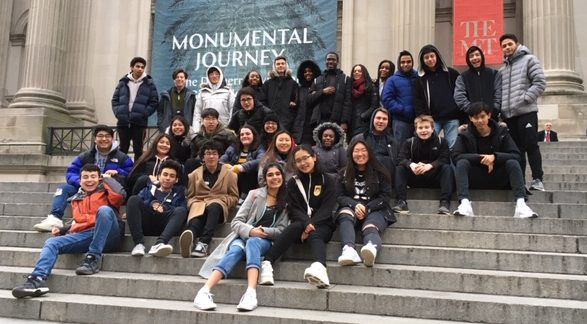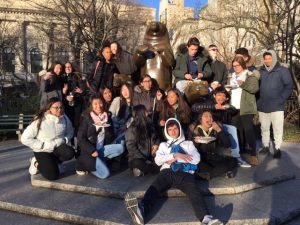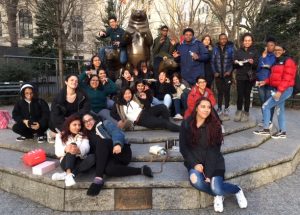Walking Through History: Analyzing American Art APUSH Students Visit the Met

DMAE AP U.S. History students were challenged to review and apply their knowledge of history at the American Wing of the Metropolitan Museum of Art February 26–28, 2019. Approximately 120 students went to the Met from 9 a.m. to 5 p.m. These trips were organized and guided by history teacher Judy Aronson.
“This is a trip I’ve done with my AP students for years,” Ms. Aronson said. “It’s a really good review for the AP U.S. History Exam because it gives us a chance to physically walk through gallery to gallery in chronological order, kind of like walking through the history we’ve studied this year,” she explained.
 Students were exposed to artwork from as early as the colonial era to as late as the Great Depression to match what they were studying in the classroom. In one of the rooms, students examined silverware produced in the Greco-Roman style by smiths like Paul Revere. A few rooms down, they observed the beautiful nature paintings of the Hudson River School, the first truly American school of painting – it was founded in 1825.
Students were exposed to artwork from as early as the colonial era to as late as the Great Depression to match what they were studying in the classroom. In one of the rooms, students examined silverware produced in the Greco-Roman style by smiths like Paul Revere. A few rooms down, they observed the beautiful nature paintings of the Hudson River School, the first truly American school of painting – it was founded in 1825.
“I got to see stuff that we learned from the beginning of the year that I almost forgot about,” sophomore Daniel Marin said.
Moreover, themes such as nationalism, industrialization, and urbanization were identified as students progressed further into the American Wing and in turn, U.S. history. Students analyzed how artwork differed before, during, and after the Civil War, a period of uncertain national identity and fractured unity. They learned about the abject poverty present in the U.S. even while its economy expanded tremendously, and how artists like the Ashcan Painters portrayed the daily lives of Americans struggling to survive in cities. WWI and its enormous impact on art were discussed, and the trip ended with Thomas Hart Benton’s giant WPA mural of the 1920s.
“Everything was very connected and looking at history through art was pretty cool,” Daniel said.
But it wasn’t all fun and games. Students received a packet containing 30 sections, one for each gallery that would be visited. Information like the approximate dates, important artists, the values and events portrayed, and a sketch of an important piece of artwork was to be filled in while touring the museum.
 Students struggled with visiting every gallery and completing the packet because of the vast amount of artwork. However, they understood that they were there to review existing knowledge through a more vivid perspective. They also realized that the galleries were organized in a logical manner, making it possible to follow the various artistic philosophies representing U.S. society during different time periods and identify the matching relationship between history and art.
Students struggled with visiting every gallery and completing the packet because of the vast amount of artwork. However, they understood that they were there to review existing knowledge through a more vivid perspective. They also realized that the galleries were organized in a logical manner, making it possible to follow the various artistic philosophies representing U.S. society during different time periods and identify the matching relationship between history and art.
“Students learn through repetition. If they read something three months ago and now it’s being reinforced on this trip, and then they look at it before the exam, maybe it’ll be of some help to them,” Ms. Aronson concluded.
AP US History is considered one of the more difficult AP classes. The exam expects students to not only know about content spanning hundreds of years, but to apply it by analyzing historical documents and making connections between different time periods. Consequently, memorization is not the most effective way to absorb information. Thinking critically about the content while reviewing key concepts are more crucial factors in gaining a wider understanding of history.

Devin Kim is a junior in the Information Systems Academy, and his second year writing for The Maroon Tribune. Besides his work as a student reporter, he...


